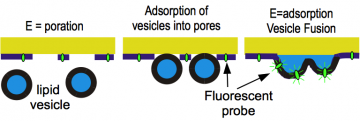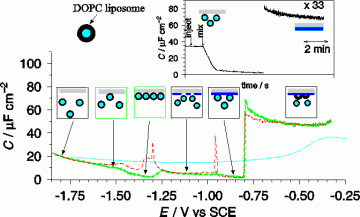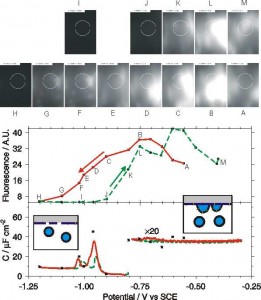Modification, by physisorption of lipid-like molecules (long chained fatty alcohols) has been studied using electrochemical and insitu spectroscopic methods.
The modification of an adsorbed fatty alcohol modified electrode surface with DOPC liposomes was shown to be only realized when the potential of the electrode surface was made negative enough so as to create defects. The liposomes interacted with these defects and became incorporated. The layer was stable when the potential was changed to 0V/SCE.
- Musgrove A, Bridges CR, Sammis GM, Bizzotto D. Potential-dependent interaction of DOPC liposomes with an octadecanol-covered Au(111) surface investigated using electrochemical methods coupled with in situ fluorescence microscopy. Langmuir. 2013;29(10):3347–3360. doi:10.1021/la400042c. (You can view the full text of this article here)
The characterization of adsorbed lipid-like layers was studied extensively on Au:
- Shepherd JL, Bizzotto D. Characterization of mixed alcohol monolayers adsorbed onto a Au(111) electrode using electro-fluorescence microscopy. Langmuir. 2006;22(10):4869–4876. doi:10.1021/la052994i.
- Shepherd J, Yang Y, Bizzotto D. Visualization of potential induced formation of water-insoluble surfactant aggregates by epi-fluorescence microscopy. J Electroanal Chem. 2002;524:54–61.
and on Hg drop:
- Agak JO, Stoodley R, Retter U, Bizzotto D. On the impedance of a lipid-modified Hg|electrolyte interface. J Electroanal Chem. 2004;562(2):135–144. doi:10.1016/j.jelechem.2003.07.030.
- Stoodley R, Bizzotto D. Epi-fluorescence microscopic characterization of potential-induced changes in a DOPC monolayer on a Hg drop. Analyst. 2003;128(6):552–561. doi:10.1039/b212924h.


